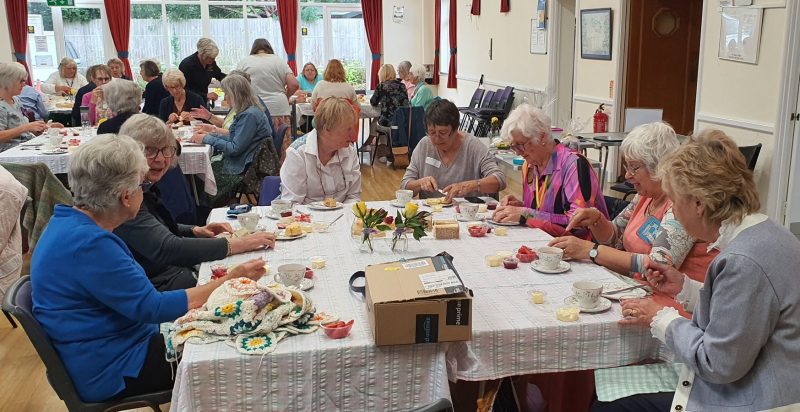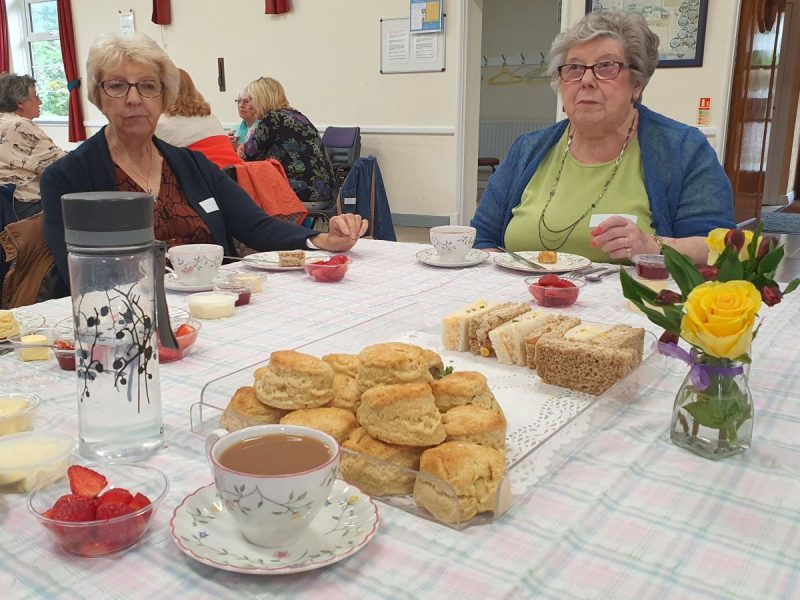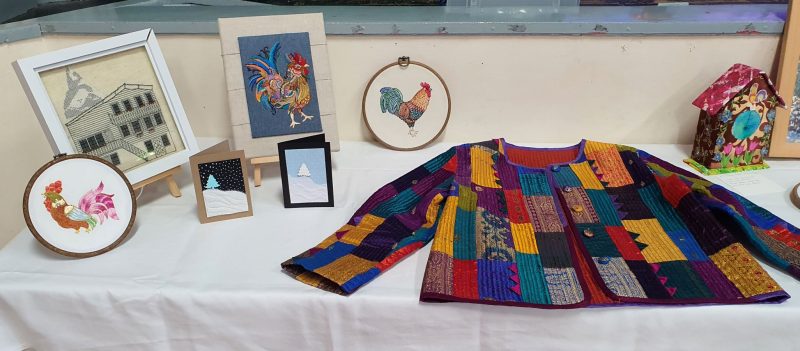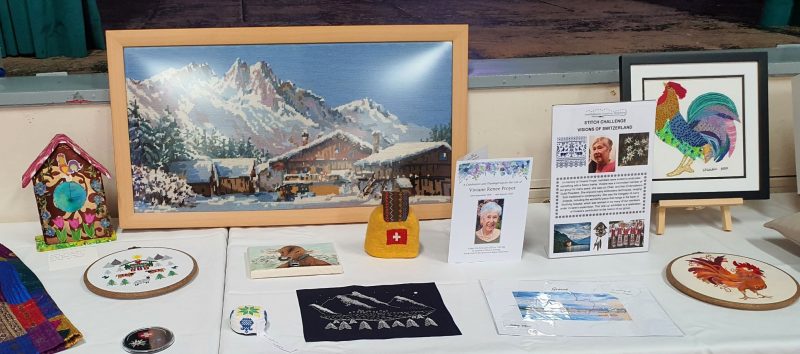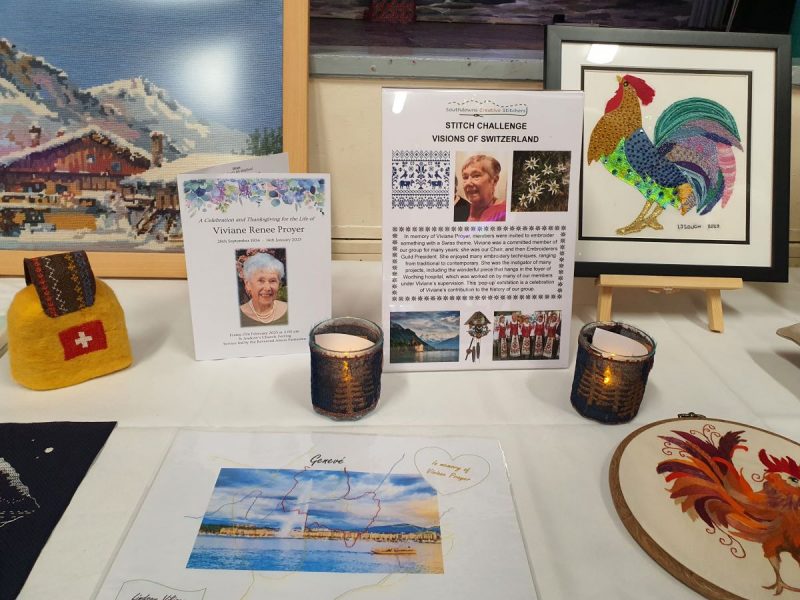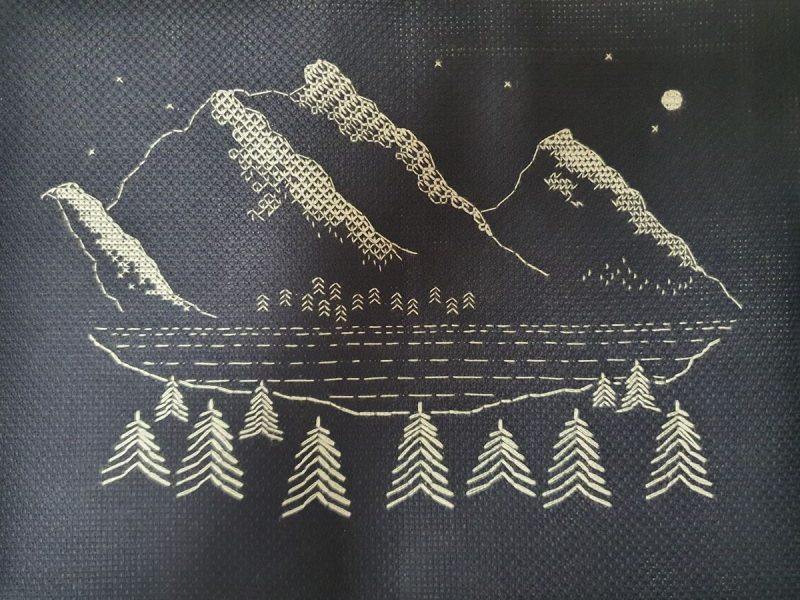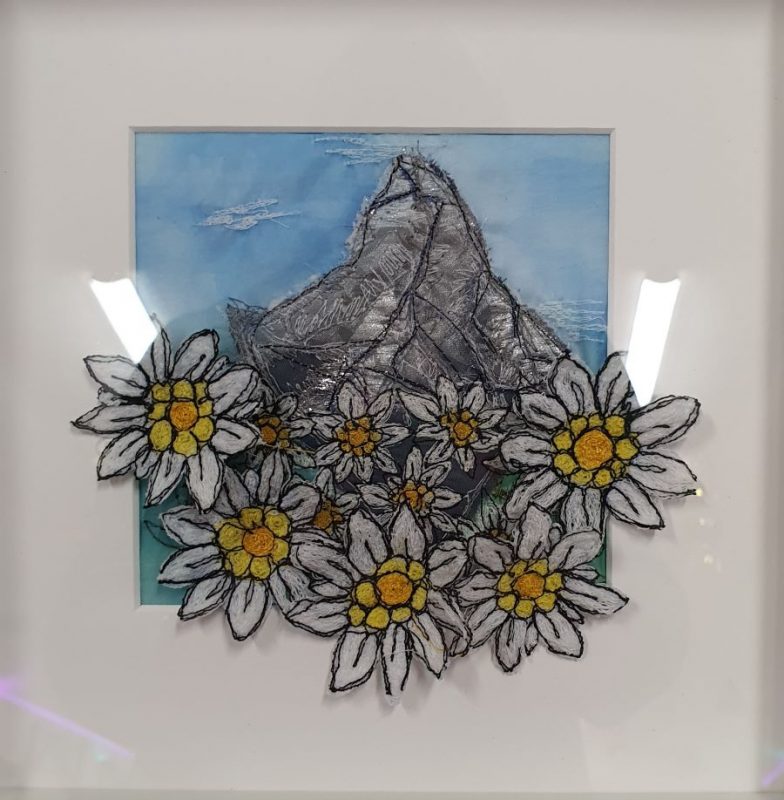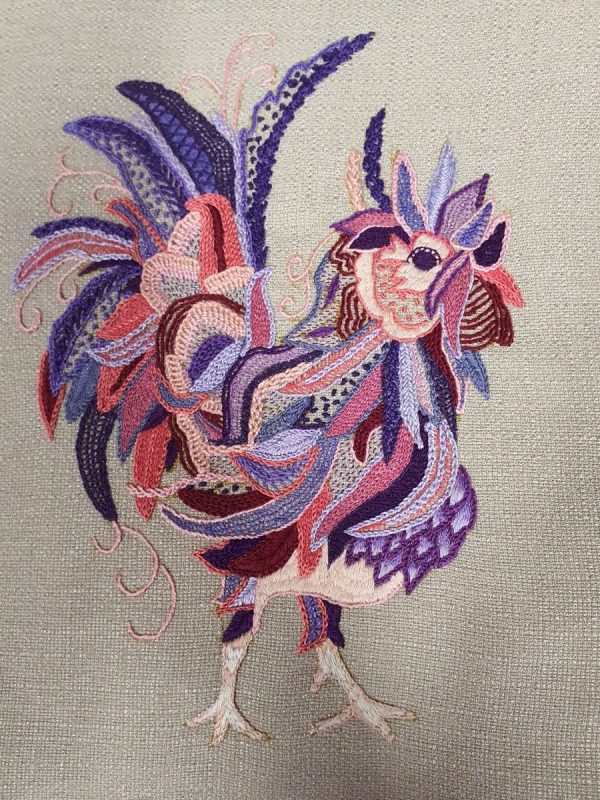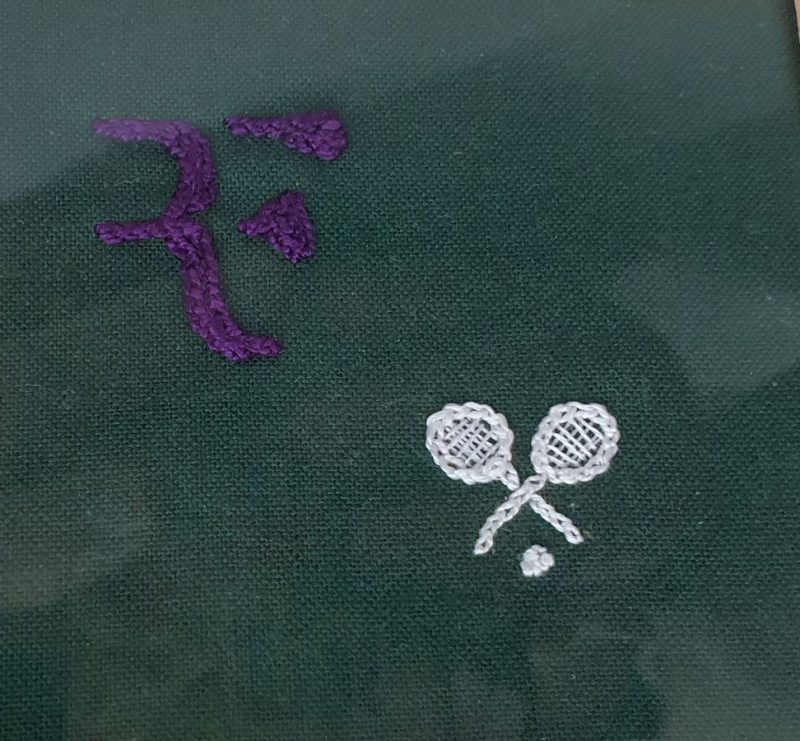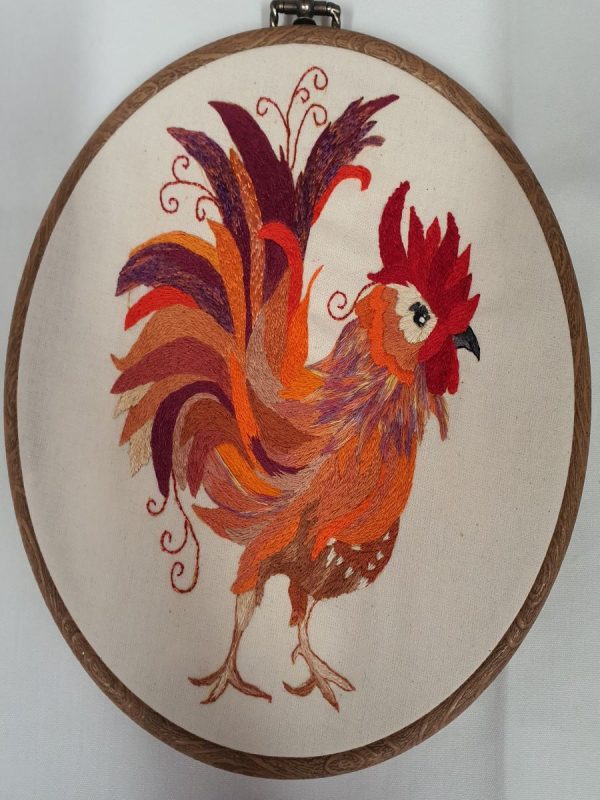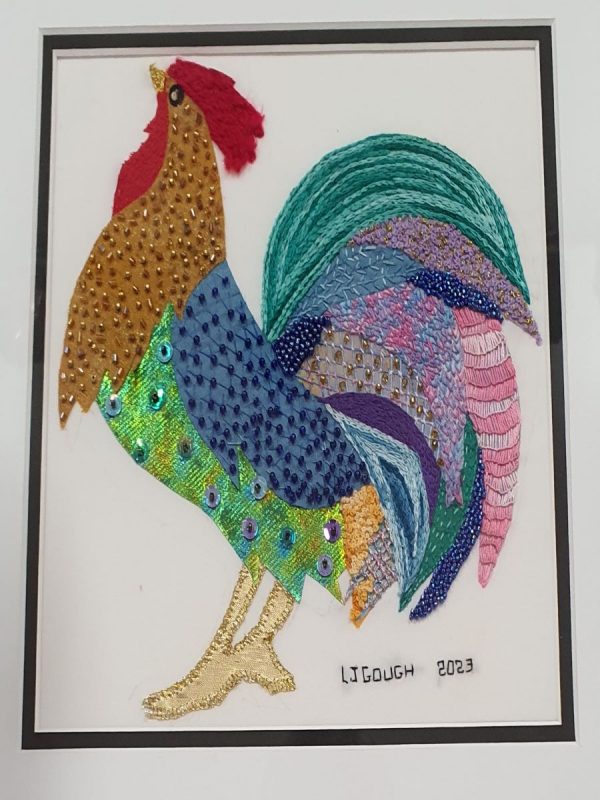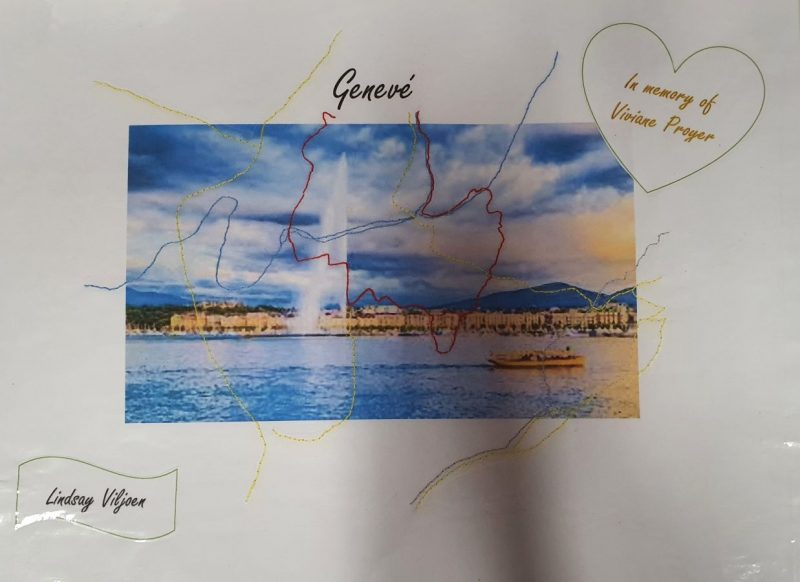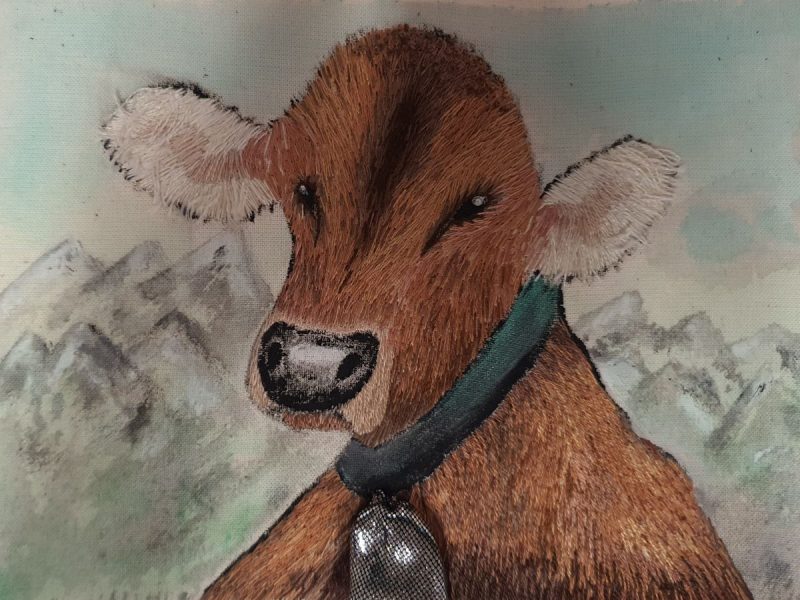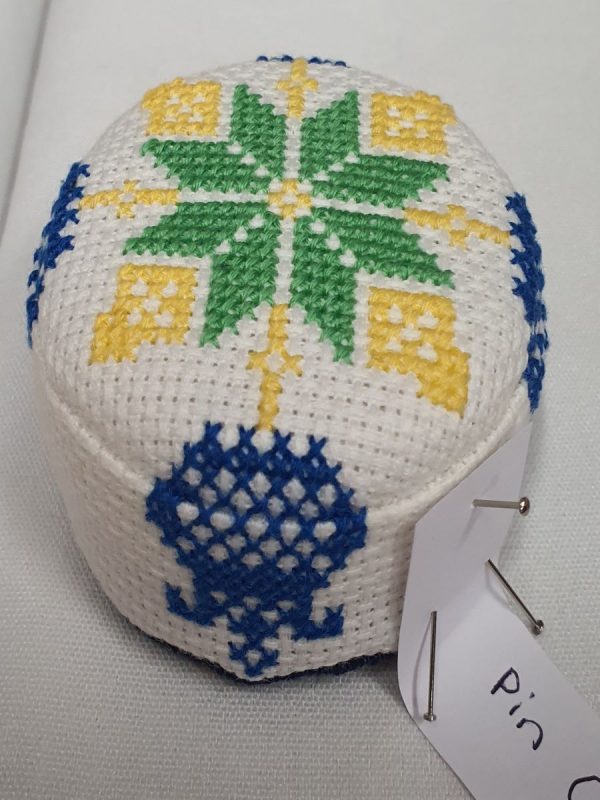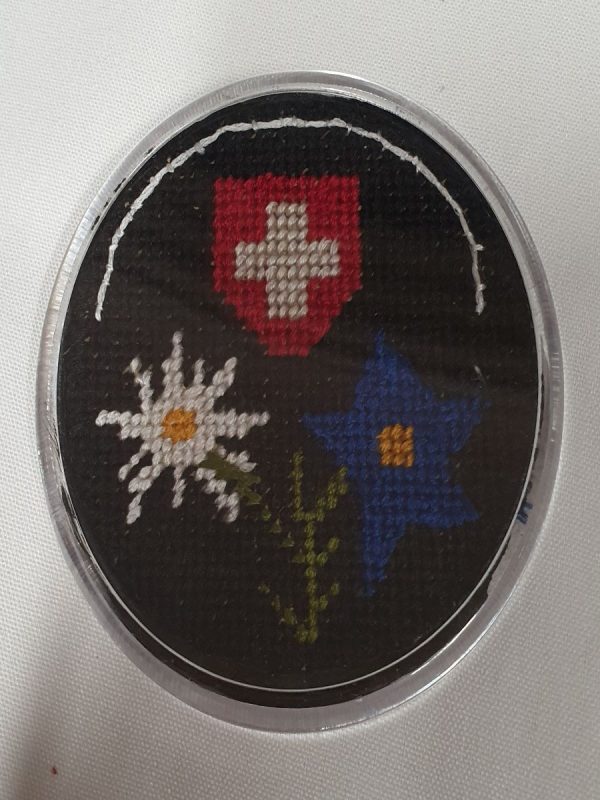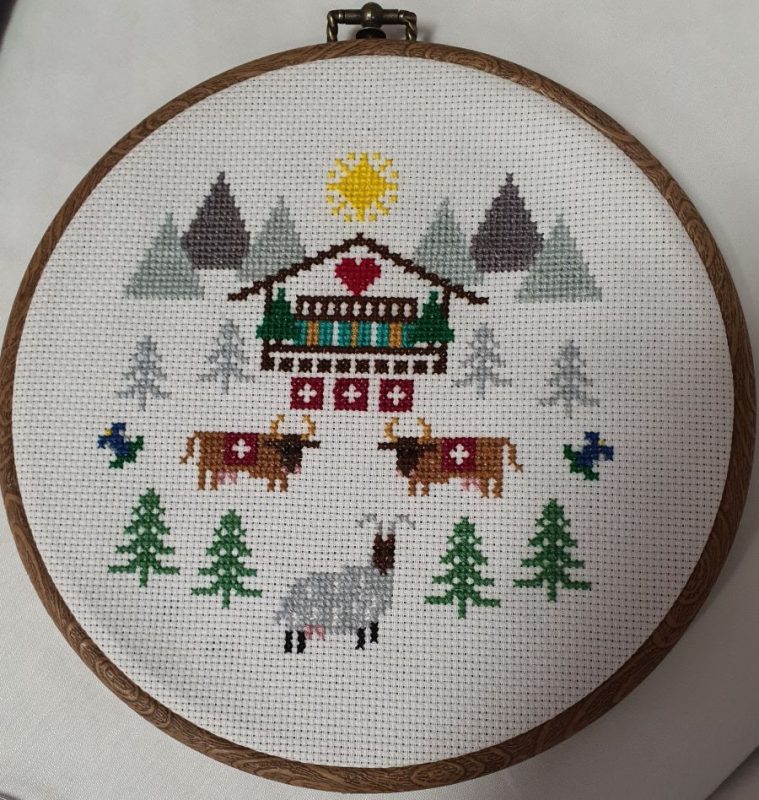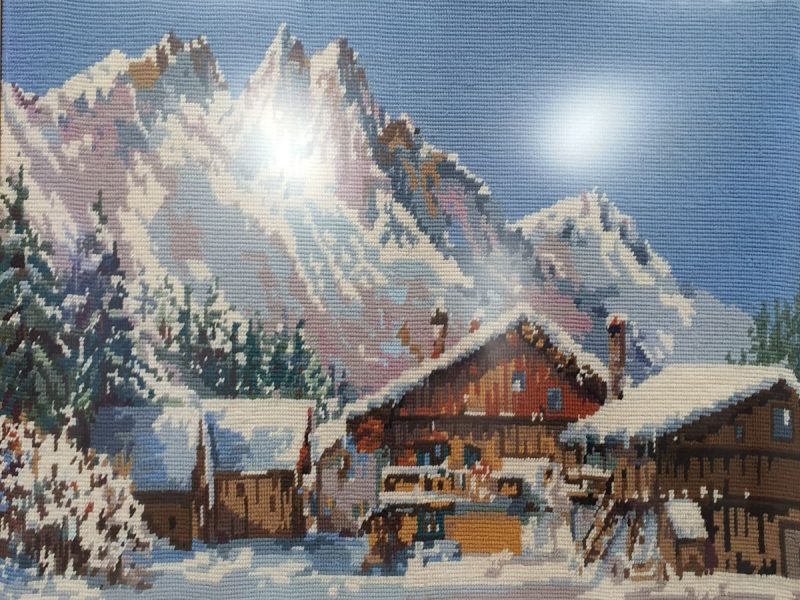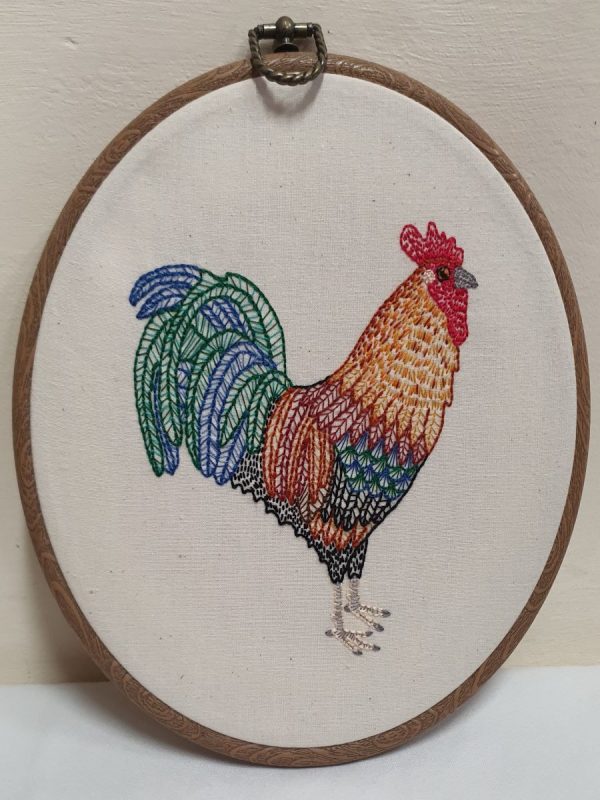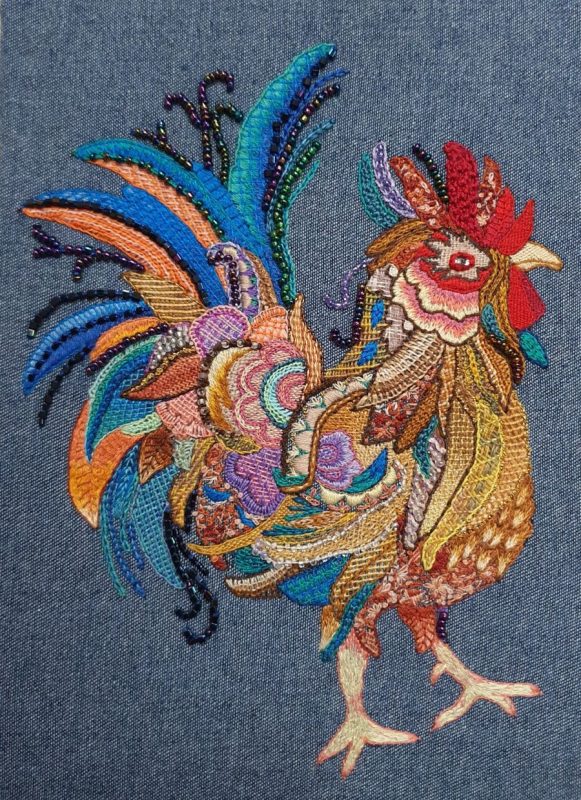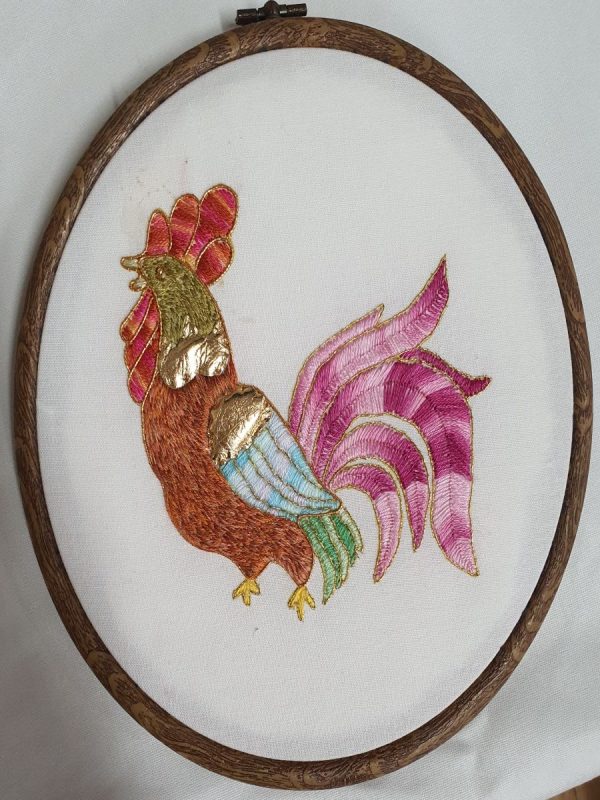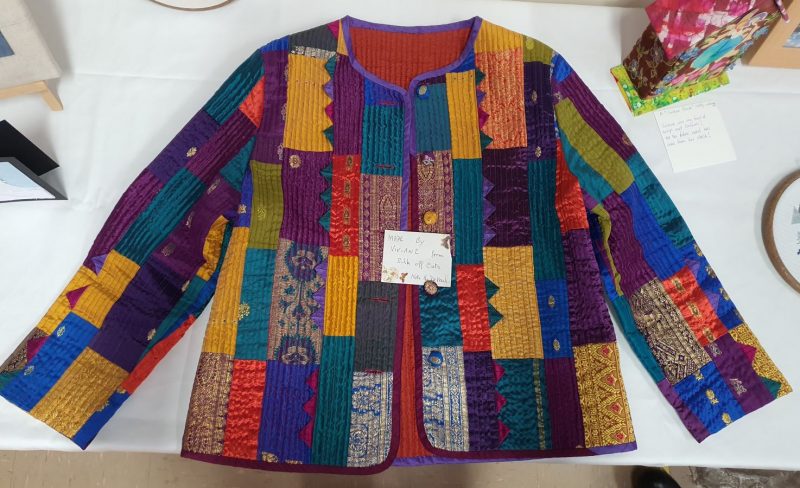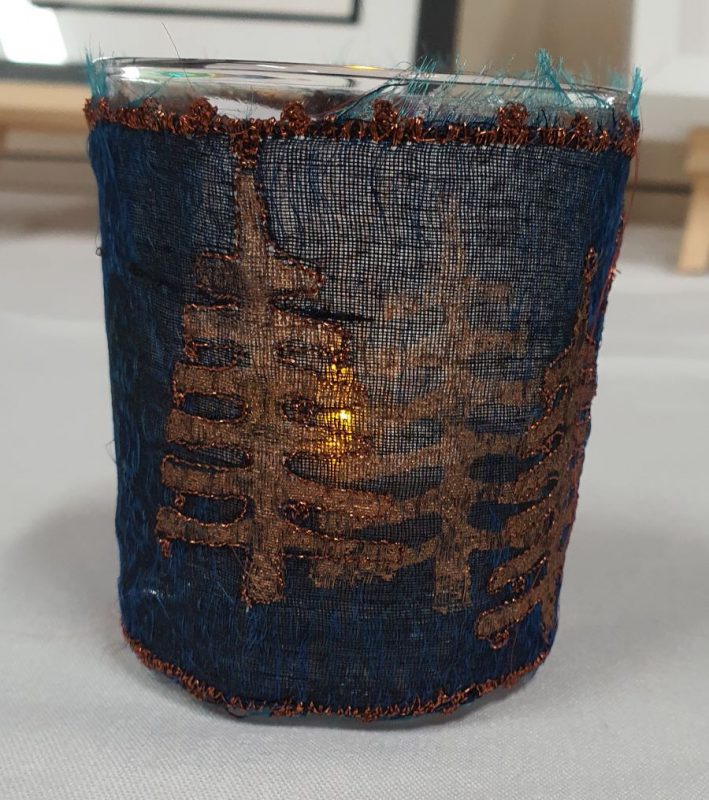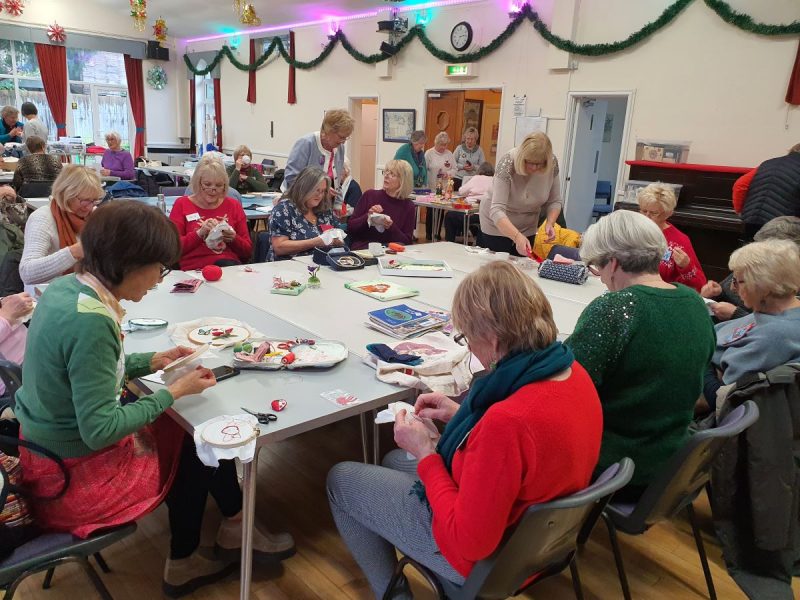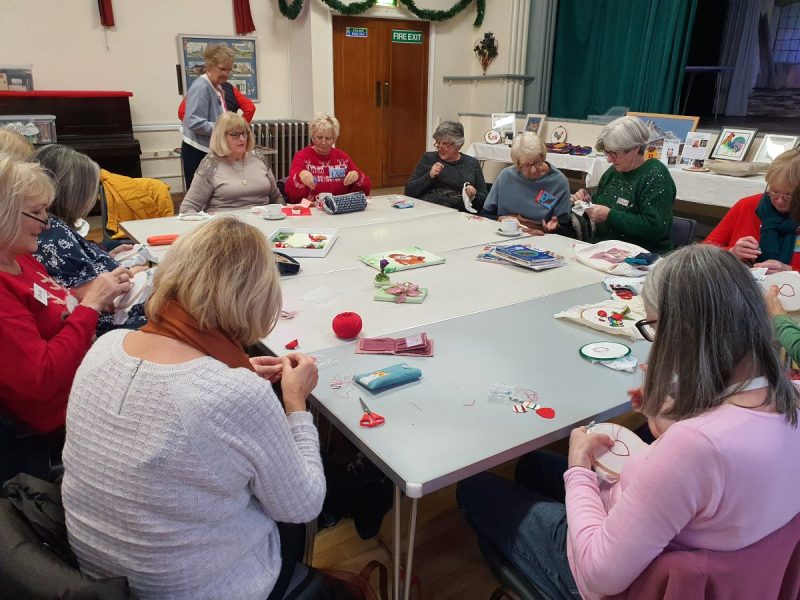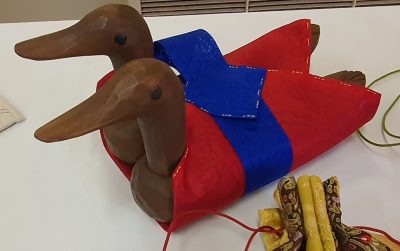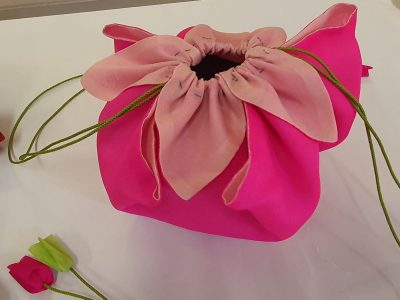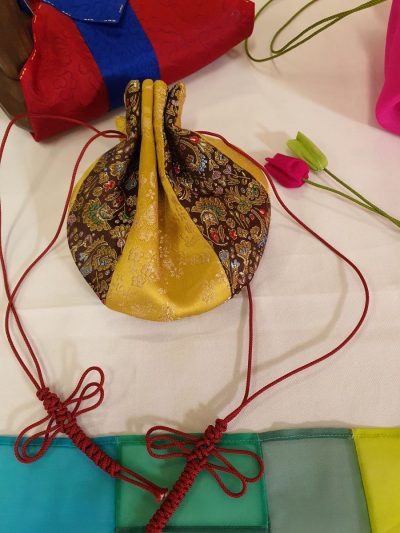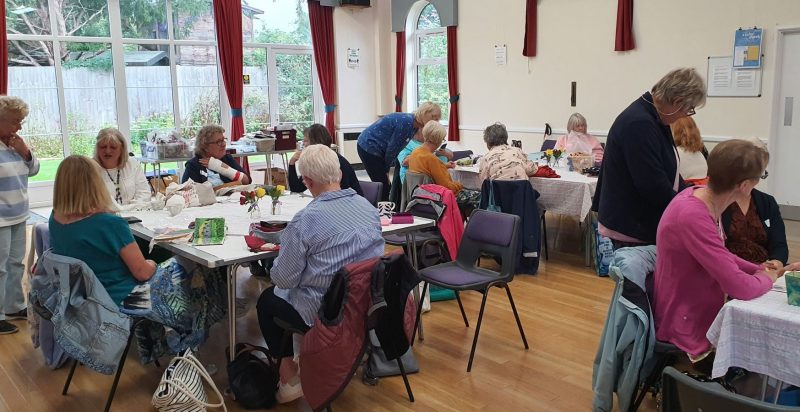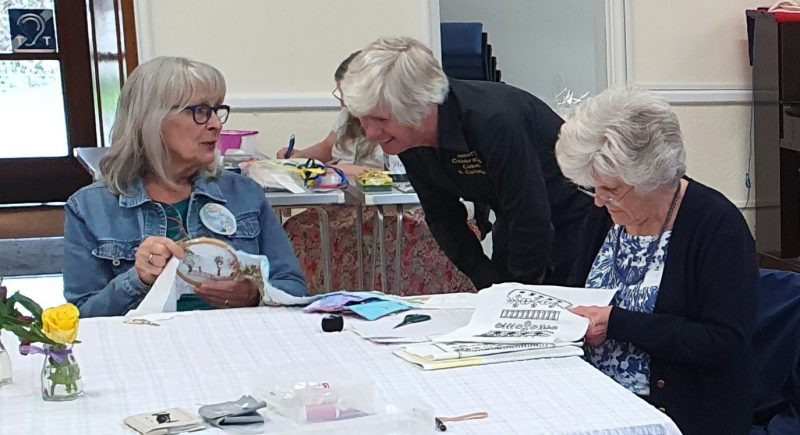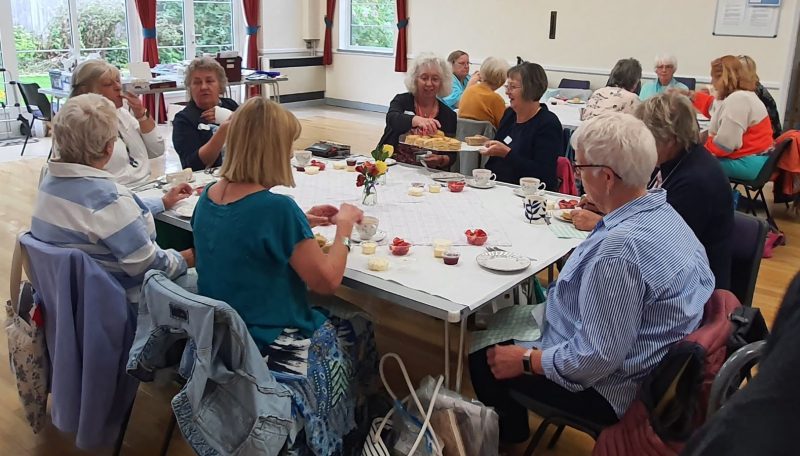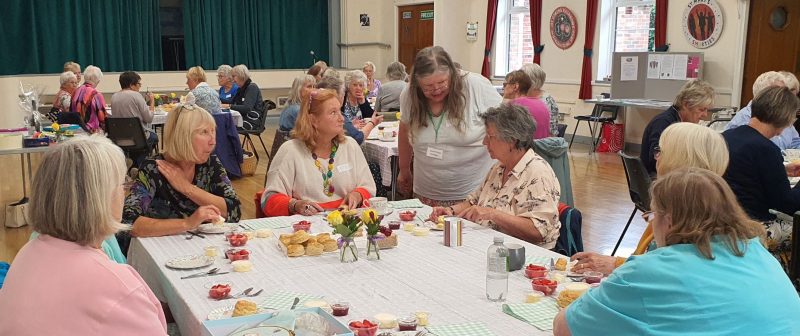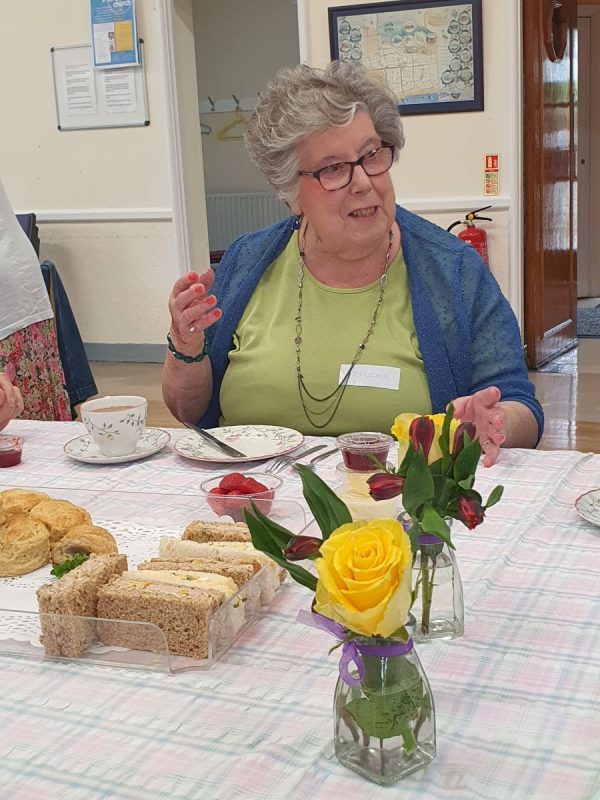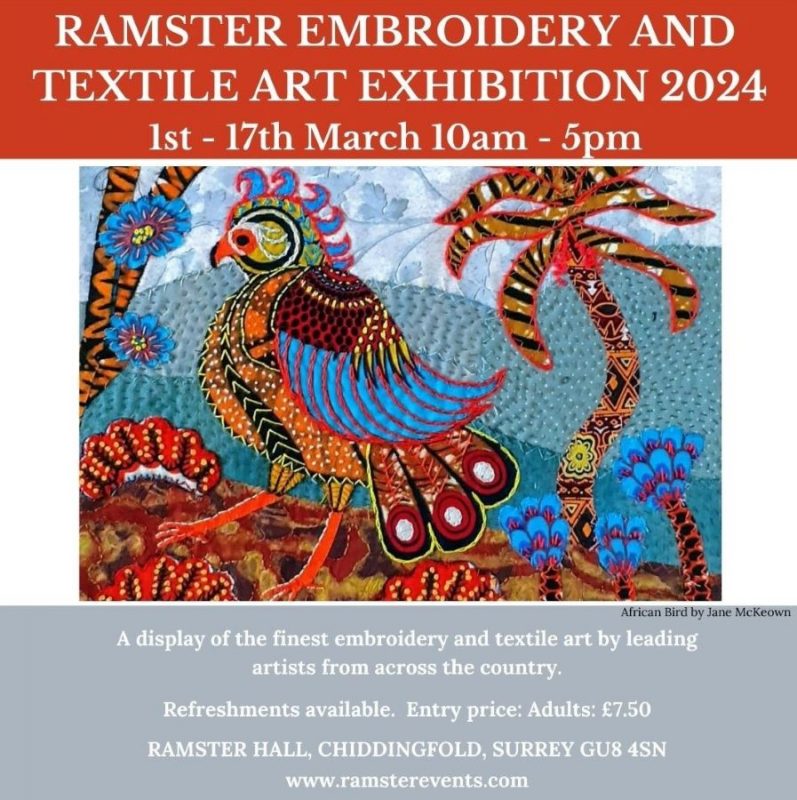 This exhibition is coming up soon. It’s in Ramster Hall, a lovely 17th Century manor house in Surrey. The exhibition will be open from Friday March 1st until Sunday March 17th every day from 10 am until 5pm. The tea room will be open at the same time. There are two large halls of embroidery / textile art exhibits, with a wide variety of styles. I know of 6 SCS members who are taking part. It’s a good day out, and the cakes are good!
This exhibition is coming up soon. It’s in Ramster Hall, a lovely 17th Century manor house in Surrey. The exhibition will be open from Friday March 1st until Sunday March 17th every day from 10 am until 5pm. The tea room will be open at the same time. There are two large halls of embroidery / textile art exhibits, with a wide variety of styles. I know of 6 SCS members who are taking part. It’s a good day out, and the cakes are good!
News
Quilts and machine embroidery
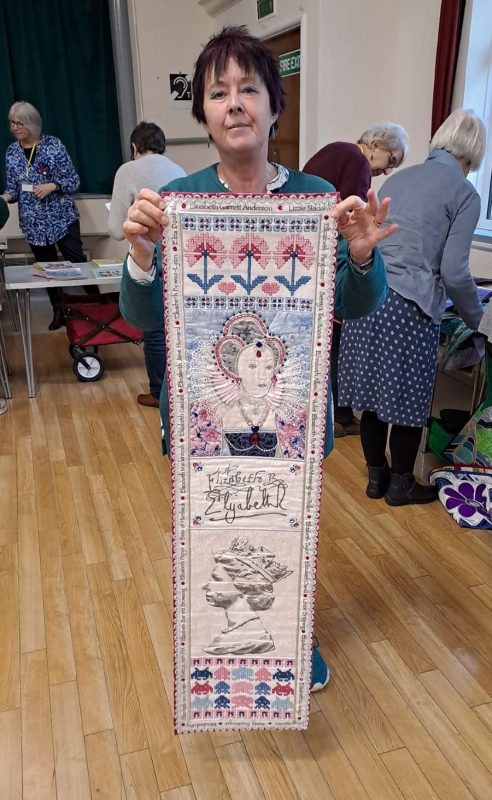
We had a great talk yesterday by Gail Lawther. There’s a description of it on our FB page, so I won’t duplicate that here. Gail didn’t want her work photographed (sadly, people sometimes steal other people’s designs) so this month I can’t post any photos here, except for this one that she kindly let Chris take. Gail is running a workshop for us on 15th March, making wall-quilts based on ‘twilight silhouettes’. There are still a few places available, although it is booking up fast so talk to a committee member if you would like to book a place.
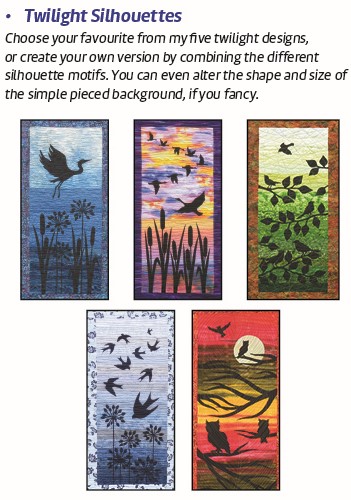
Several members have said to me recently that they don’t feel confident going on workshops that involve the sewing machine. If you want a gentle introduction to machine embroidery, Esther Collins is starting a new course near Pulborough (not too far from sunny Worthing) where she will start with the basics and take you through it step by step. It’s six evenings in February and March. It should give you the confidence to join other workshops such as the one by Gail Lawther above. Details in the link below.
Christmas with a Swiss theme
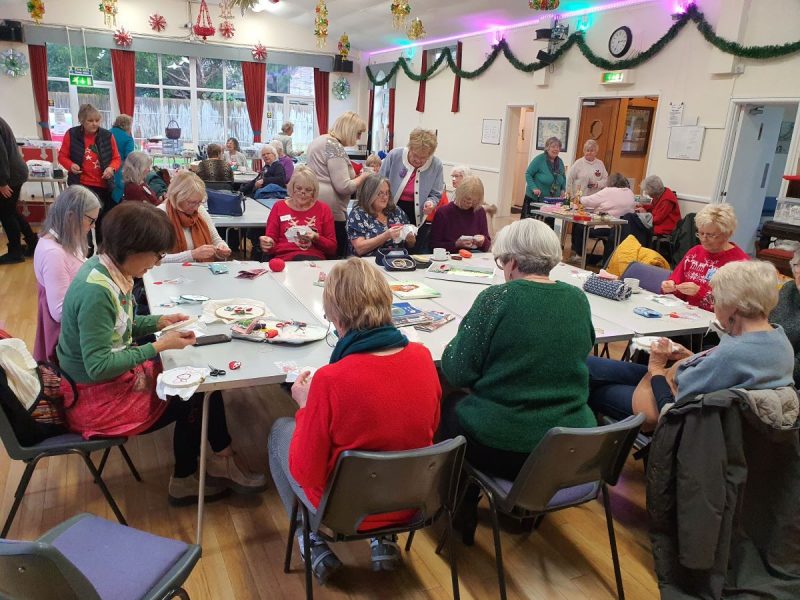 Our December meeting was a ‘sit and sew’ afternoon. There was lots going on; there was a pop-up exhibition of Swiss-themed embroidery, and Swiss-themed cakes and biscuits, as well as ‘Stitch Corner’ where Daphne kindly showed members how to create a stump-work strawberry brooch. I took lots of photos of people stitching, but none of the strawberries so if someone would like to send me a strawberry photo then I will add it.
Our December meeting was a ‘sit and sew’ afternoon. There was lots going on; there was a pop-up exhibition of Swiss-themed embroidery, and Swiss-themed cakes and biscuits, as well as ‘Stitch Corner’ where Daphne kindly showed members how to create a stump-work strawberry brooch. I took lots of photos of people stitching, but none of the strawberries so if someone would like to send me a strawberry photo then I will add it.
 There were lots of wonderful entries to the ‘Visions of Switzerland’ pop-up exhibition. This was in celebration of the life of SCS member Viviane Proyer, long-standing member, accomplished embroiderer, and friend to many. An earlier post here includes an account of Viviane learning to sew in Switzerland as a child. You can read it by clicking the link here. There were lots of entries, and some very varied images and techniques. There was even a fully-functioning felted cow-bell! I’ll let the images speak for themselves; scroll down to see some lovely and imaginative work.
There were lots of wonderful entries to the ‘Visions of Switzerland’ pop-up exhibition. This was in celebration of the life of SCS member Viviane Proyer, long-standing member, accomplished embroiderer, and friend to many. An earlier post here includes an account of Viviane learning to sew in Switzerland as a child. You can read it by clicking the link here. There were lots of entries, and some very varied images and techniques. There was even a fully-functioning felted cow-bell! I’ll let the images speak for themselves; scroll down to see some lovely and imaginative work.
The Korean art of Bojagi
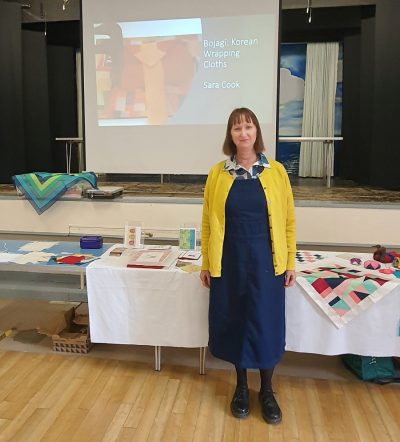
We had a fascinating talk this month by Sara Cook, on the Korean art of Bojagi. Sara is a quilter, tutor and quilting judge, who was drawn to this specialist technique after seeing an exhibition of Korean textiles. She was already an experienced quilter, and this particular technique caught her imagination straight away – so much so that she booked a trip to the Korean Bojagi Forum in 2016 (in Korea) to study it first-hand. Since then she has developed her own interpretation of this ancient technique and has taught the subject all over the world.
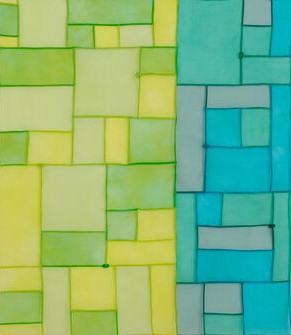
Bojagi originates from the art of wrapping, both for practical/functional reasons and also for decorative reasons such as giving presents. It was used for every-day use such as food storage, sometimes waxed to seal the food and keep it fresh. It was also used to store personal belongings, since space was at a premium and homes were cleared of personal items when they weren’t in use. Thicker layered cloths were made for warmth, usually from silk as it is warm in winter and cool in summer. Functional items could also be very decorative, like the heavily stitched thumbles below (the second photo is a thimble-making kit that you can buy via Sara’s website)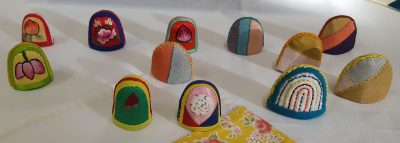
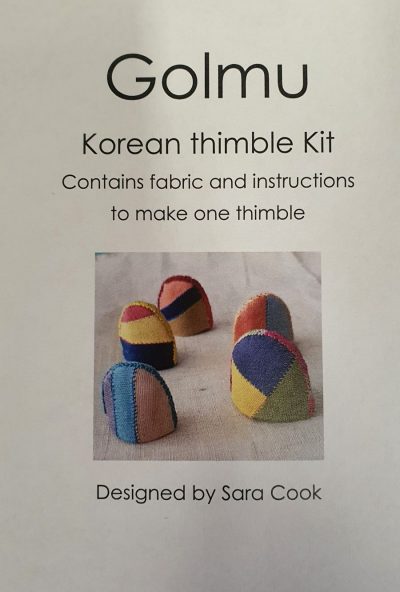
Sara spoke about the role of women in traditional Korean society. Women were expected to obey firstly their father, secondly their husband, and thirdly their son. Education was not permitted, and women could not leave the house without a male escort. When a woman married, she would leave her family home and would probably never see her family again, so the cloths made with her mother and sisters may have had particular significance in her new home. The giving of gifts was highly symbolic: for example ducks and geese, with blue and red to symbolise yin and yang.

Korean cultural traditions changed significantly since occupation and the war years. The position of women has improved, but alongside that there ha been concern about losing cultural traditions as society modernises. Korea introduced an innovative cultural heritage programme. People with traditional skills are appointed as ‘national treasures’ and are given subsidised studios that enabled them to pass on their skills. This has led to techniques such as Bojagi being kept alive across the world. Sara has developed her own style of work using traditional Bojagi techniques. It involves a very particular and precise type of seam, and is worked to be hung against the light so that it’s translucent qualities are shown off to best advantage. You can see more of her work on her website at https://bojagiuk.com/
Hand and Lock Visit
Ten of us from our group took the train up to London to visit Hand and Lock who have been producing fine embroidery for royalty and celebrities since 1767. We were taken into the ‘BeadRoom’ where two of the embroiderers told us about their work and how they came to be embroiderers for Hand and Lock.
Some interesting facts from our tour:
*Military uniforms for royalty are made with real gold braid (2% gold) film set uniforms use fake gold.
* When making a uniform like the one modelled by Susie, individual pieces are embroidered, it is then made up by a tailor then the embroidery is finished.
*Hand and Lock did much of the embroidery for the coronation but sadly they were not mentioned on the programme about the coronation tailors. They worked on Penny Mordant’s fabulous sea green coat, Queen Camilla’s shoes and 52 goldwork flags for Burberry’s flagship stores and the Household Cavalry uniforms.
* They work with skilled embroiderers in India who are mostly men. * They also do lots of machine embroidery for many other clients.
* They run loads of different embroidery courses on line. Check out their website.
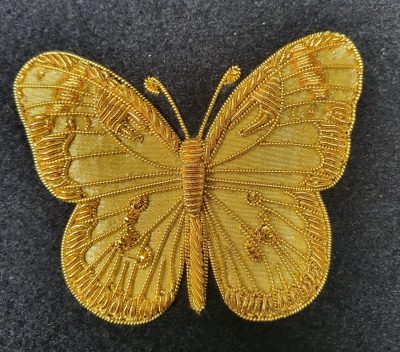
The following photos give you a taster of the embroidery we saw.
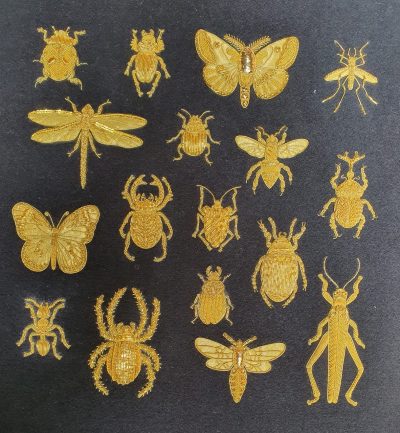
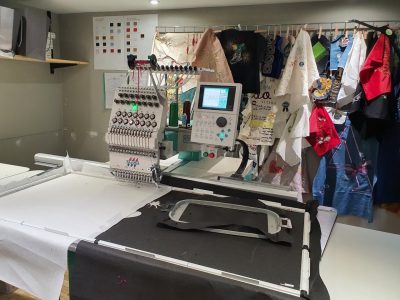
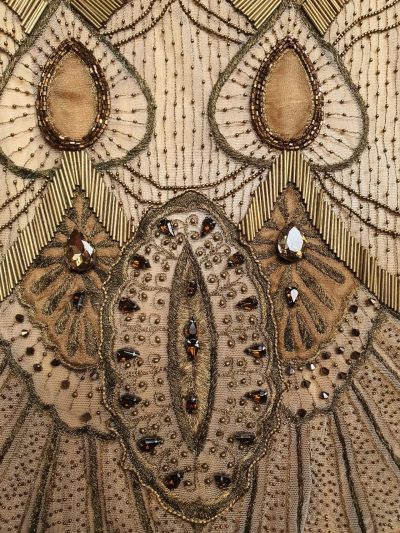
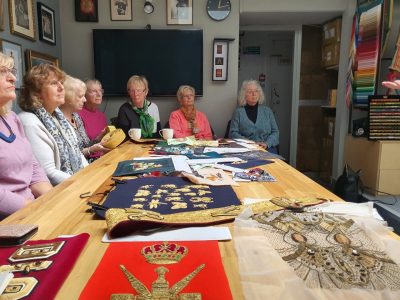
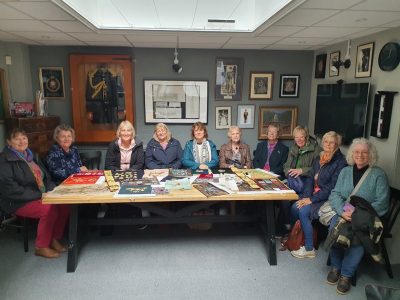
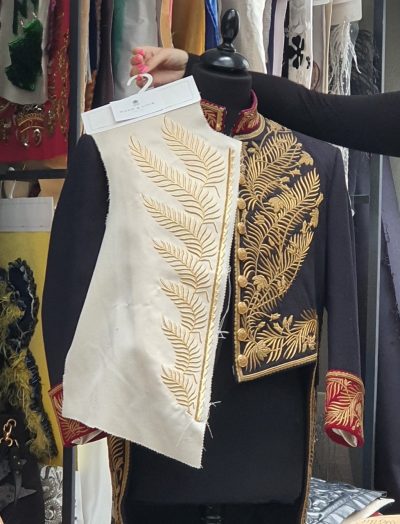
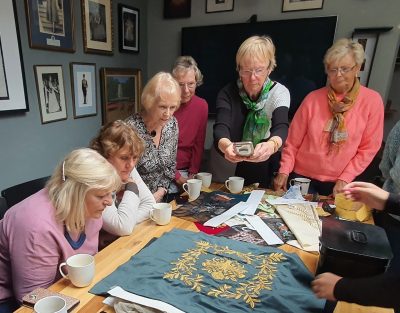
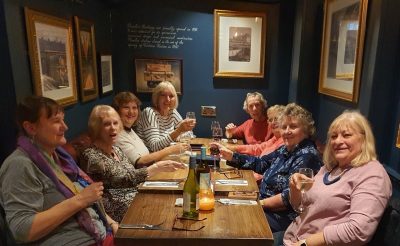
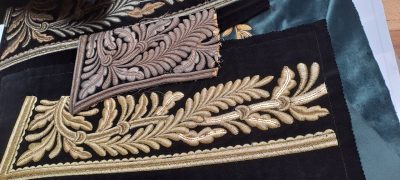
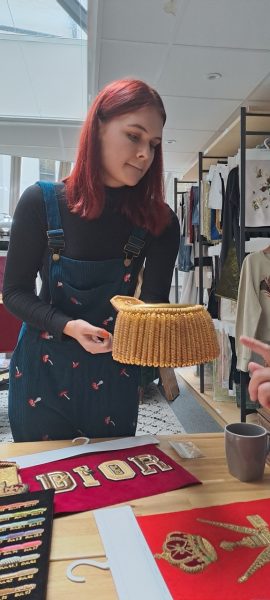
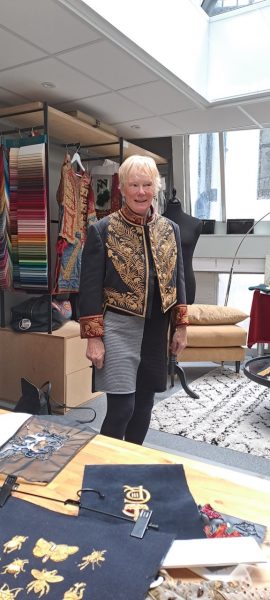
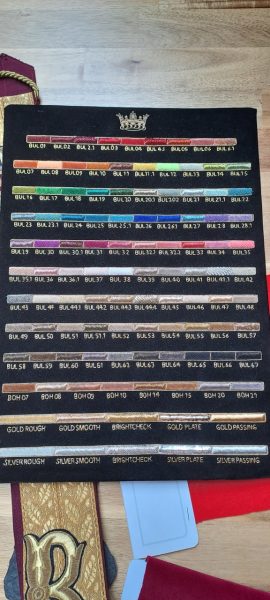
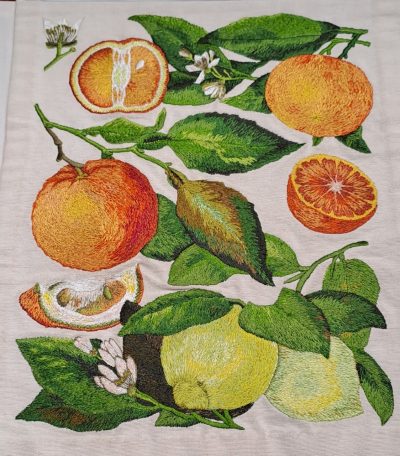
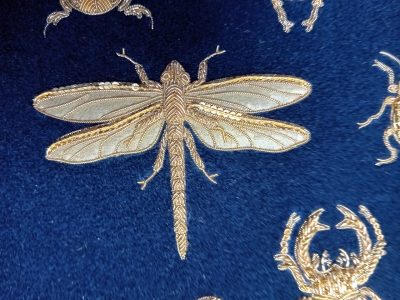
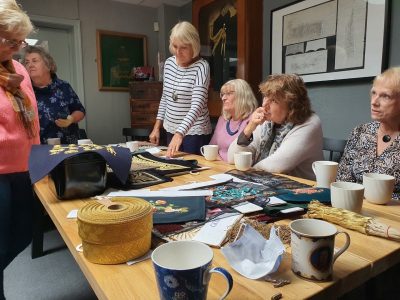
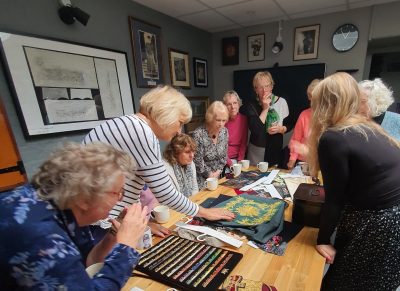
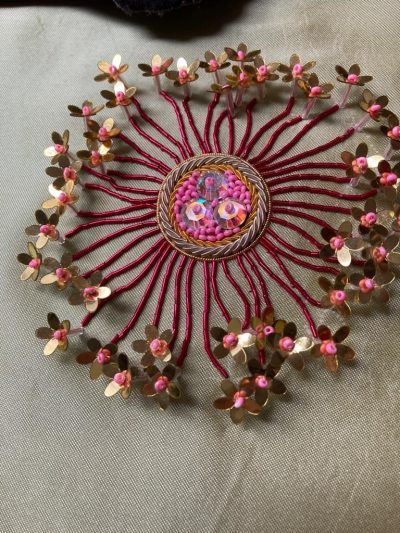
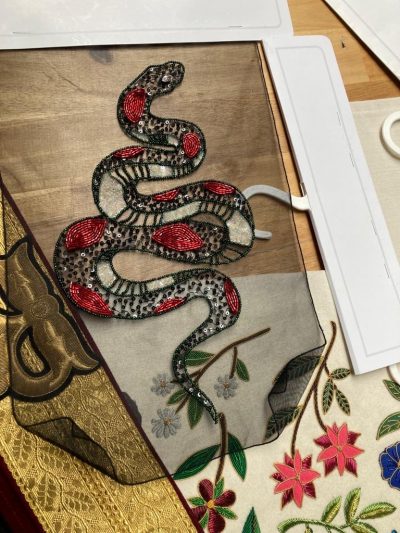
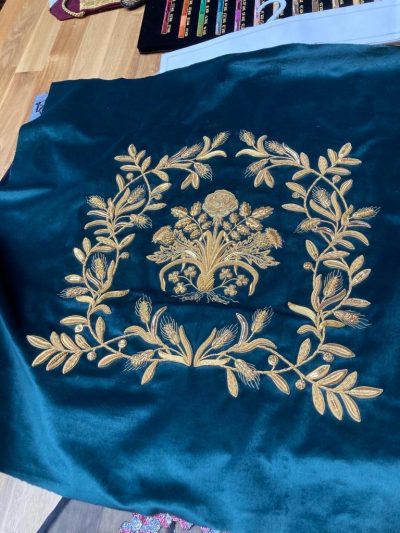
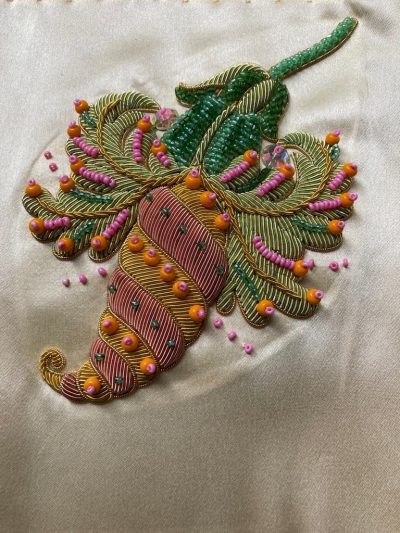
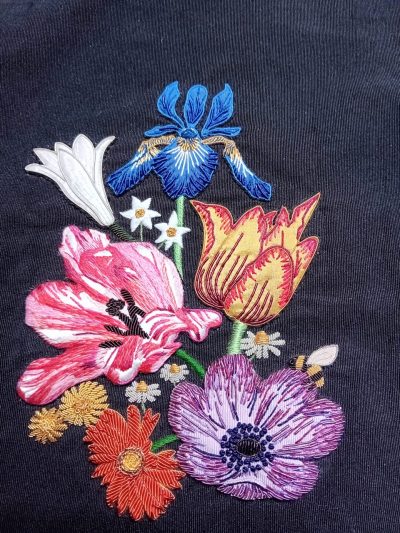
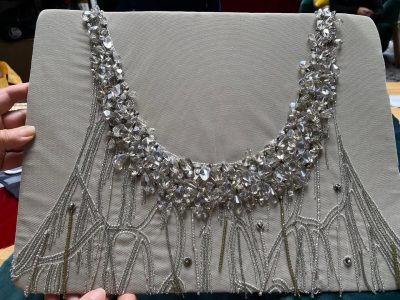
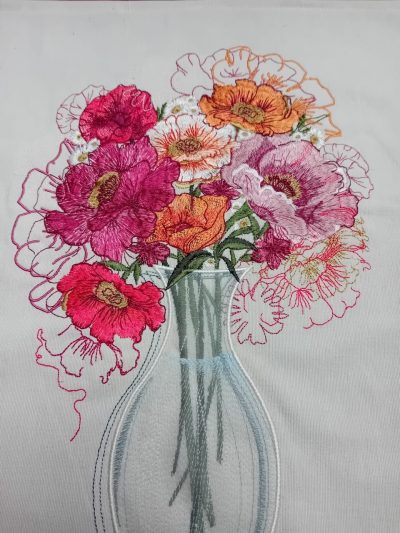
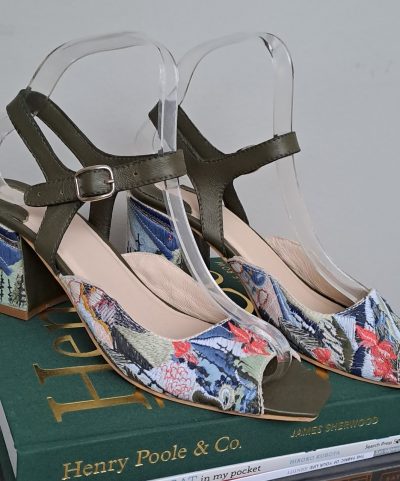
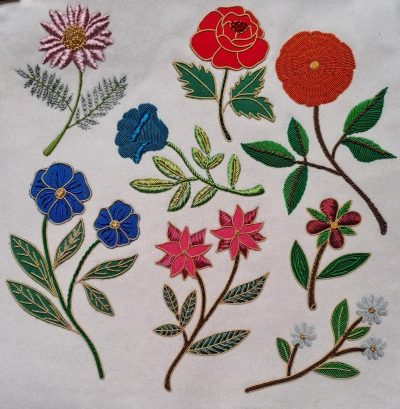
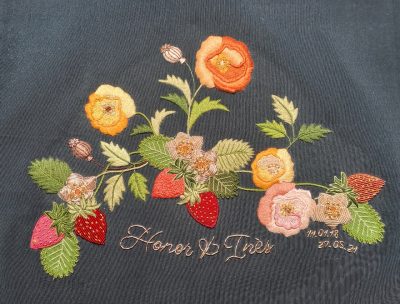
Findon Christmas Tree Festival
 This month in our sit and sew session we worked on decorations for our Christmas Tree to be displayed at the Findon Christmas Tree Festival on 2nd and 3rd December, at St John the Baptist Church . The theme was gold hoops with a gold backing and members had free reign to creat a decoration. Watch this space to see the finished items and our tree!
This month in our sit and sew session we worked on decorations for our Christmas Tree to be displayed at the Findon Christmas Tree Festival on 2nd and 3rd December, at St John the Baptist Church . The theme was gold hoops with a gold backing and members had free reign to creat a decoration. Watch this space to see the finished items and our tree!
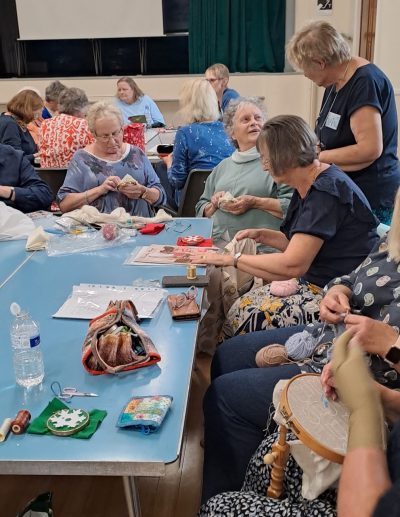
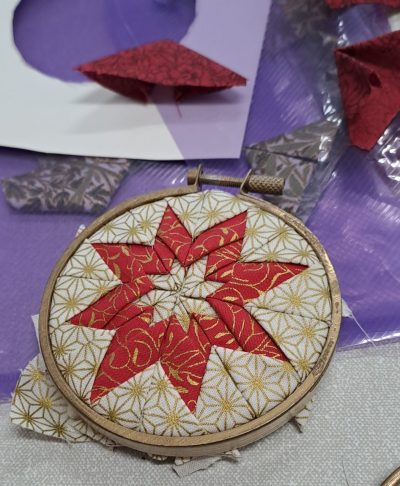
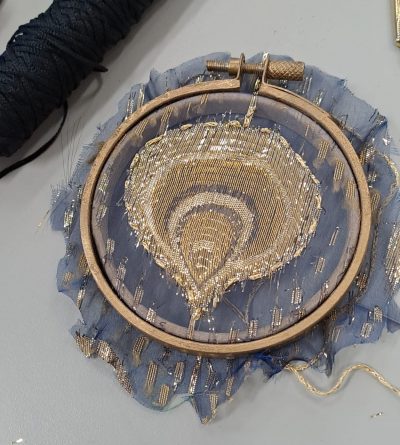
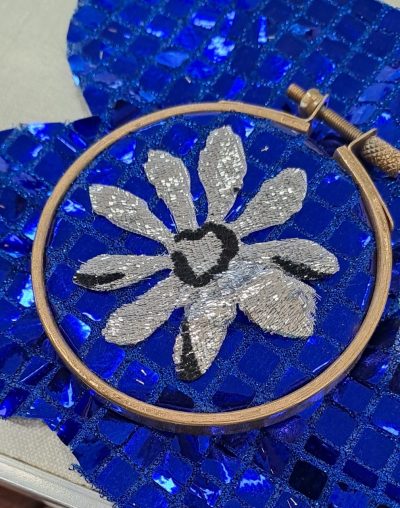
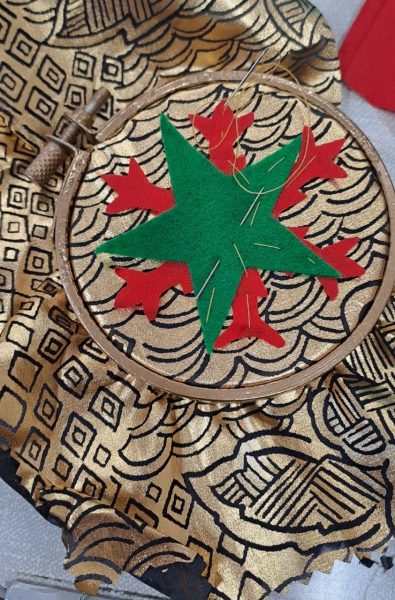
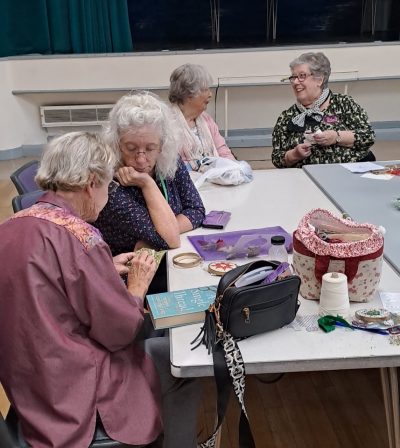
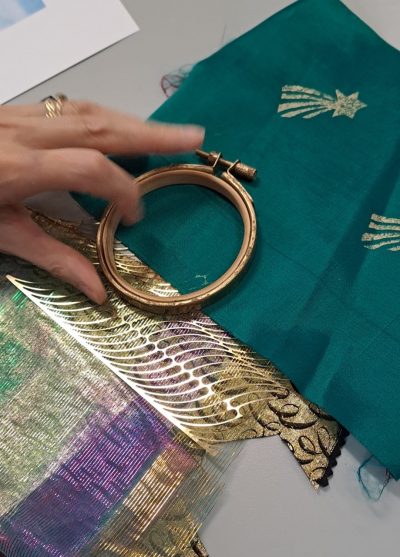
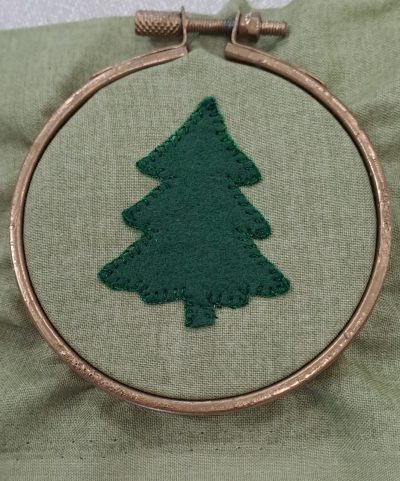
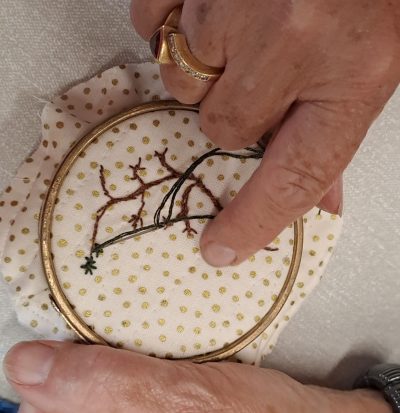
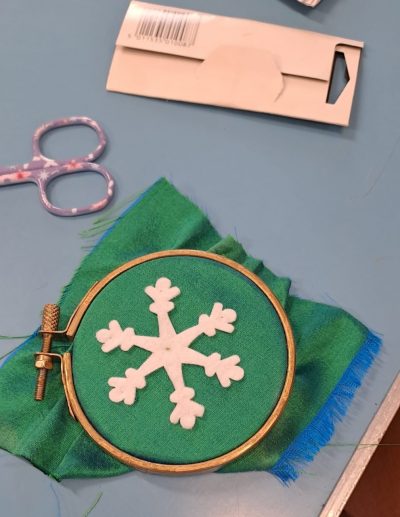
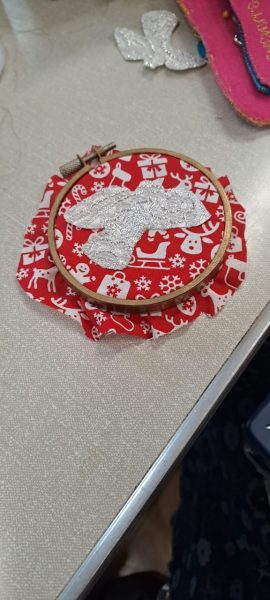
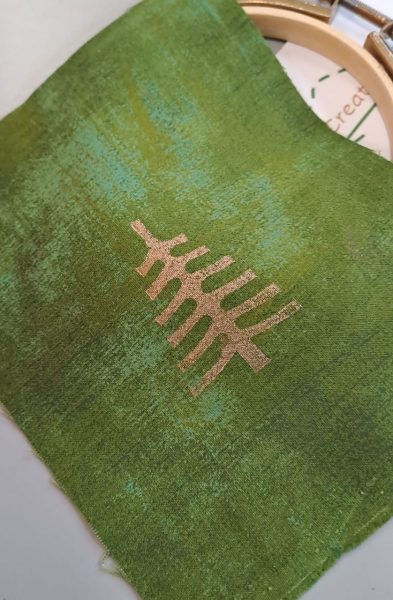
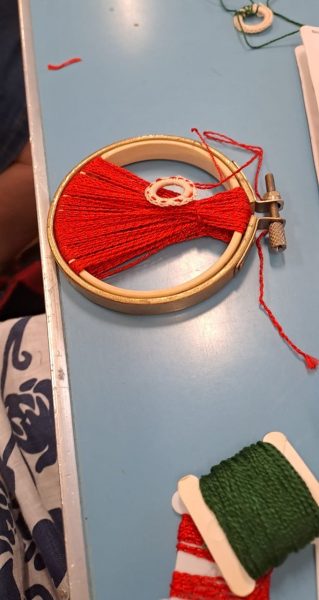
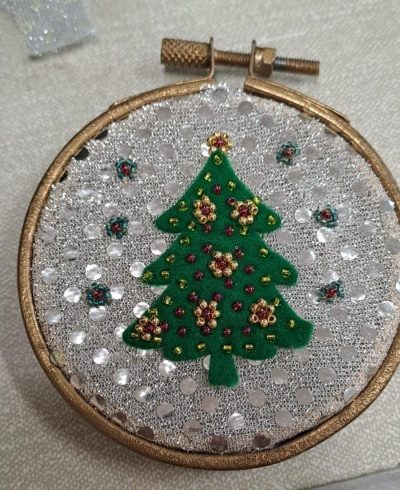
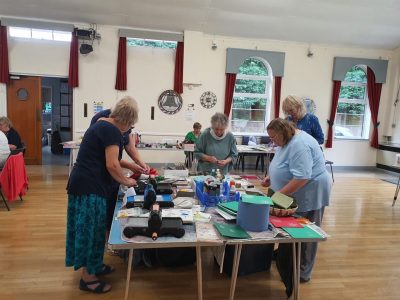
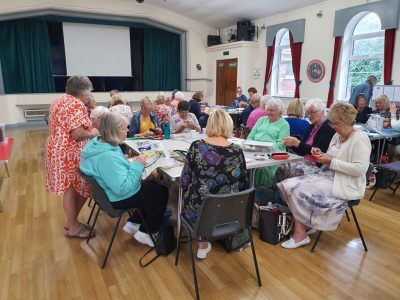
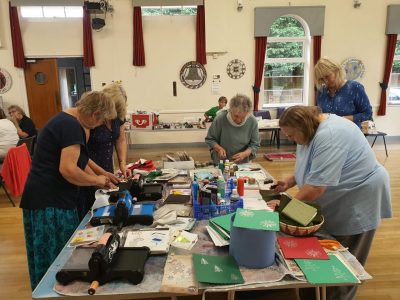
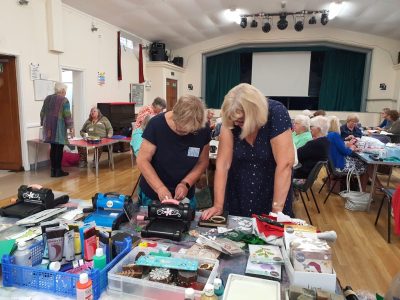
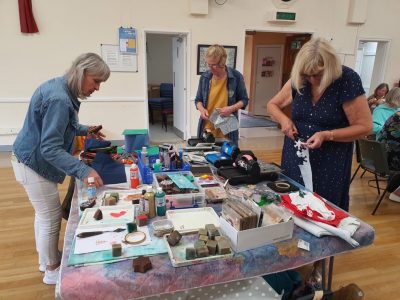
New art from old treasures
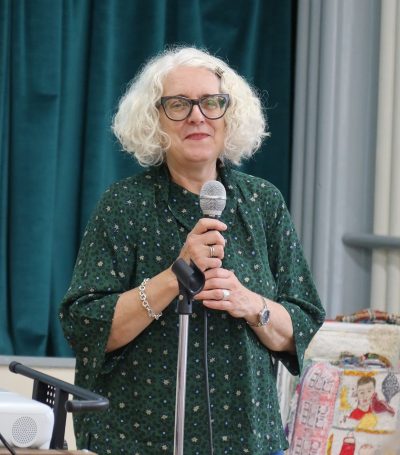 Thanks to Chris for this description of Tuesday’s talk by Anne Kelly.
Thanks to Chris for this description of Tuesday’s talk by Anne Kelly.
‘Today we had an interesting talk from textile artist and Author Anne Kelly. Anne is resident artist at Sussex Prairie gardens and lots of our members have been there to workshops with her. Anne brought lots of examples of her unique style of art using paper, hand and machine embroidery and reclaimed fabrics. She is a well travelled artist, originating in Canada and putting on shows in Australia, France and India to name but a few places. She likes to exhibit her work in places like hospitals and hospices and not just art galleries. Anne does lots of commissions and likes working on old maps which she treats with PVA glue and tissue paper before stitching onto them. She feels strongly about reusing old fabrics and putting them to new use. Lots of her work had bits of old embroidery stitched into it. She has an exhibition in Hackney coming up’.
The details of Anne’s exhibition in October are in the poster below. Scroll down below that for lots of photos of the work that Anne brought with her to show the group, and there are more lovely things to look at on her website https://annekellytextiles.com/ 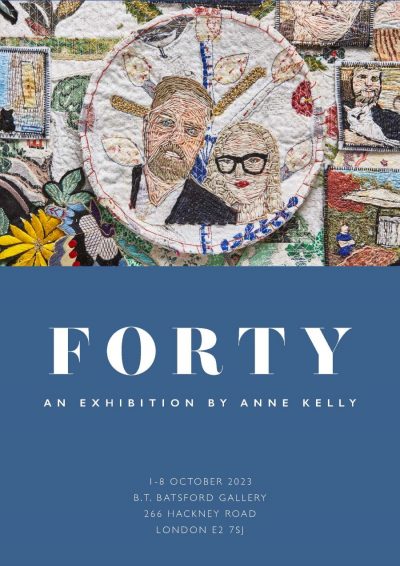
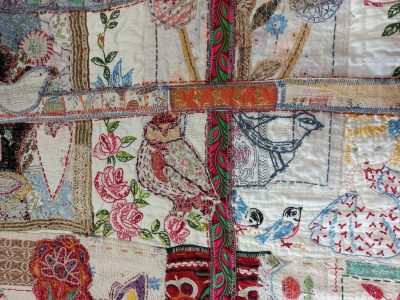
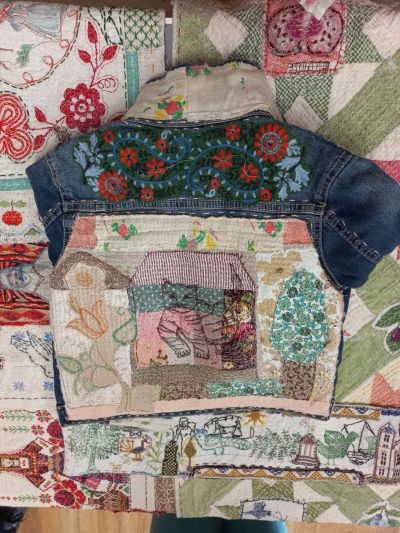
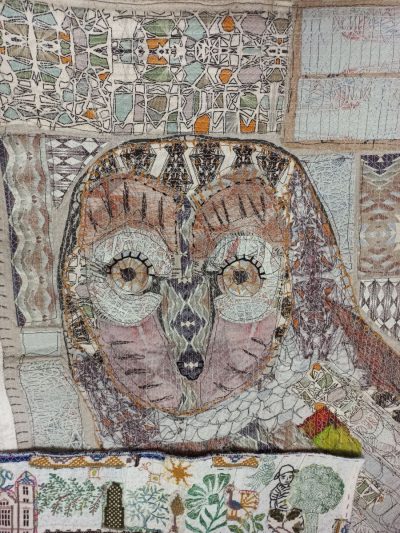
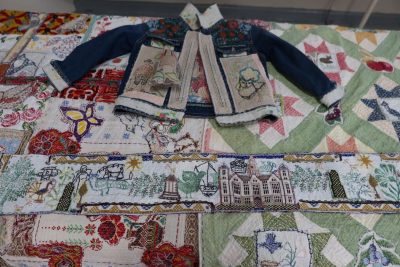
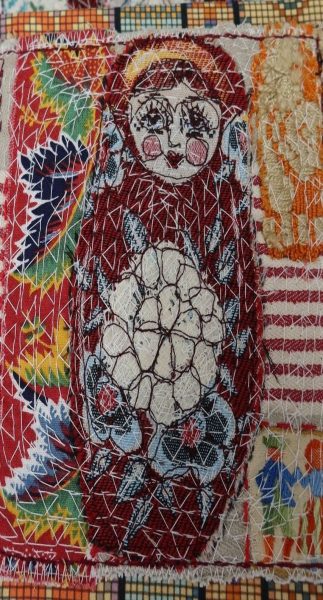
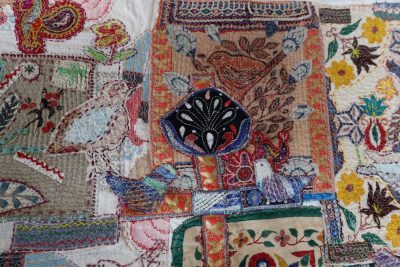
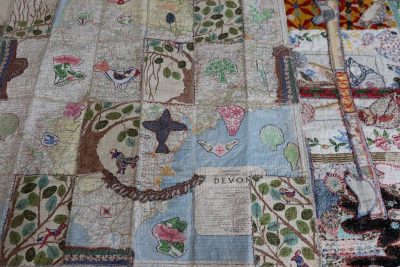
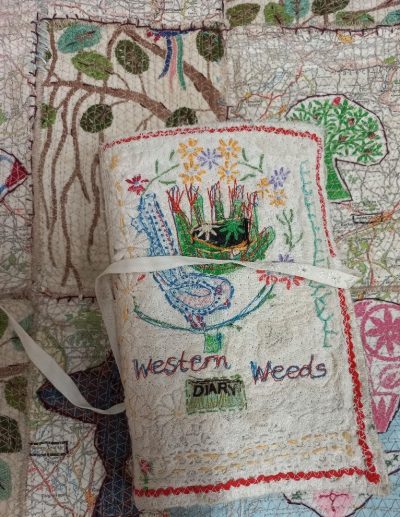
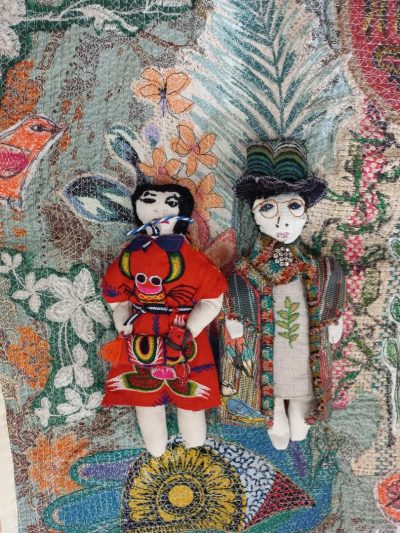
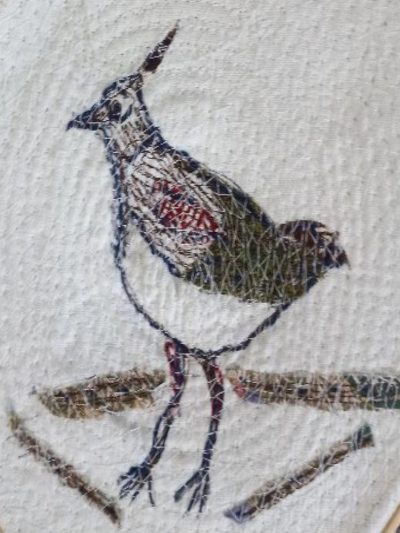
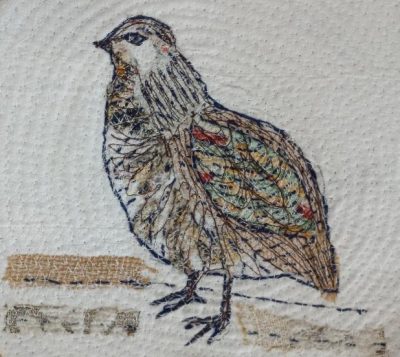
Tea and scones
 Instead of the summer picnic that we had for our August meeting in the last two years, this year we decided to have a catered ‘posh tea’ instead. This turned out to be a stroke of luck, given the wind and rain that afternoon. Thankfully we weren’t holding on to gazebos that were trying to take off into the field! Valerie kindly organised the caterer, as well as finishing touches such as floral tea cups and table-cloths. Thanks to Margaret for providing floral table-decorations (despite the fact that she was on her way to catch a flight). We were treated to scones with jam and cream, a selection of sandwiches, several different cakes, and strawberries and cream. Naughty but nice! There was a little bit of stitching before tea was served, but when sticky things appeared the sewing was mainly put away. Here are a selection of photos of us stitching beforehand, and then enjoying the feast. If anyone is looking for a cake-maker or caterer, she is Janet Spoor at ‘Janet’s celebration Cakes and Catering’.
Instead of the summer picnic that we had for our August meeting in the last two years, this year we decided to have a catered ‘posh tea’ instead. This turned out to be a stroke of luck, given the wind and rain that afternoon. Thankfully we weren’t holding on to gazebos that were trying to take off into the field! Valerie kindly organised the caterer, as well as finishing touches such as floral tea cups and table-cloths. Thanks to Margaret for providing floral table-decorations (despite the fact that she was on her way to catch a flight). We were treated to scones with jam and cream, a selection of sandwiches, several different cakes, and strawberries and cream. Naughty but nice! There was a little bit of stitching before tea was served, but when sticky things appeared the sewing was mainly put away. Here are a selection of photos of us stitching beforehand, and then enjoying the feast. If anyone is looking for a cake-maker or caterer, she is Janet Spoor at ‘Janet’s celebration Cakes and Catering’.